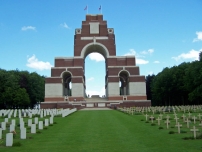| First Name: | Albert Ernest | Last Name: | BINEHAM | |
|---|---|---|---|---|
| Date of Death: | 01/10/1916 | Lived/Born In: | Blackheath | |
| Rank: | Private | Unit: | London20 | |
| Memorial Site: | Thiepval Memorial, France | |||
Current Information:Enlisted-Blackheath
The Battle of the Somme (July-November, 1916) By the beginning of October, 1916, the Battle of the Somme had been raging for three months. Thousands of men had already been killed or wounded or were simply missing, never to be seen again and and just a few square miles of the French countryside, nearly all in the southern part of the battlefield, had been captured from the enemy. Mistakes had been made by the various commanders and would be continued to be made but there was no turning back as the British, Australians, South Africans, New Zealanders and Canadians carried on battering away at the German defences in the hope of a breakthrough, So it continued all the way through to November with nearly every battalion and division then in France being drawn into it at some stage. In the end the German trenches had been pushed back a few more miles along most of the line but the cost in lives had been staggering. By the end of the fighting in November, 1916, British Army casualties numbered over 400,000, killed, wounded and missing. On 1st October, 1916, a new offensive was begun by the British Army. The Battle of Transloy Ridge was the last major operation fought during the battle of the Somme and it continued throughout the first three weeks of the month until the terrible conditions of rain, mud and cold coupled with the sheer exhaustion of the troops, brought things to a standstill. The aim had been to push the enemy further back to the next ridge of higher ground running between Le Transloy and Warlencourt. It was a very hard fight, progress was painfully slow, the casualty figure was shockingly high and the final objective was not achieved despite the best efforts of the attacking divisions. Three factors worked against its success. The first was the weather. It was simply awful. The second was the miles of war torn terrain which soon became a quagmire over which troops, guns, ammunition and all the other supplies had to cross to reach the front and keep the momentum of the offensive going. For the Germans, falling back on their own supply lines across relatively unscathed ground, this was not such a problem. The third factor was the new methods of defence employed by the enemy. They defended in depth without a well defined front line but rather setting up machine-gun nests in shell holes and other strategically important sites where just a few men could hold up an entire battalion. And of course, the German artillery had the whole area covered. At 3.15pm on 1st October, 1916, 141 Brigade of 47th (London) Division attacked towards Eaucourt l’Abbaye with 17th London, 19th London and 20th London plus two tanks. On the right flank 19th London got to within 50 yards of the German line at which stage machine-gun fire became too heavy and they had to seek cover until the tanks arrived on the scene and dealt with this problem. This allowed 19th London to capture the Flers Support Line. With the tanks then moving left along this enemy trench line, 20th London were able to move further forward past Eaucourt l’Abbaye where they and 19th London linked up with the New Zealanders on their right. On the left of the brigade front, 17th London were unable to make progress in the face of heavy machine-gun fire and eventually were forced back to their starting line. The casualty list for 20th London on this day was a very long one and it included Albert Bineham. |
||||
| « Back to Search Results | ||||
| If you think any of the information shown here is incorrect, Click Here to submit your amends and comments | ||||




